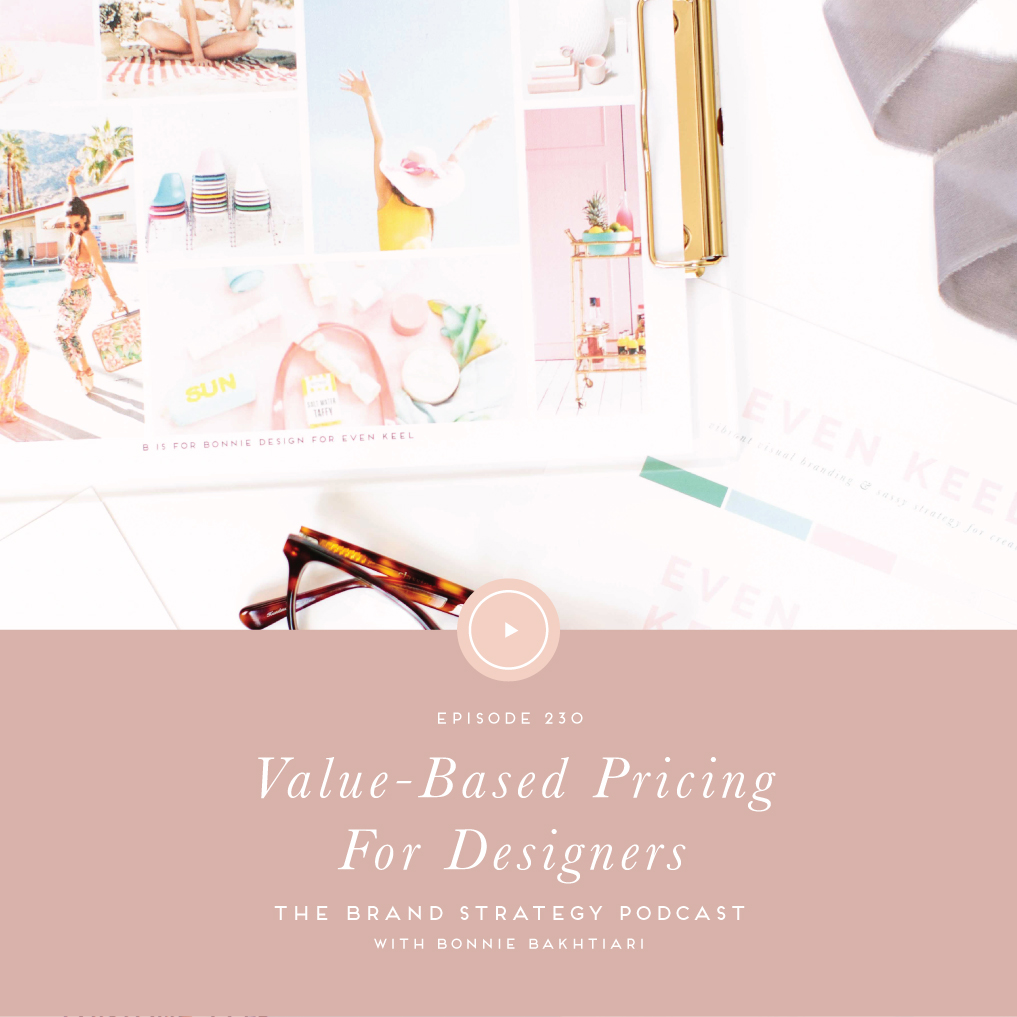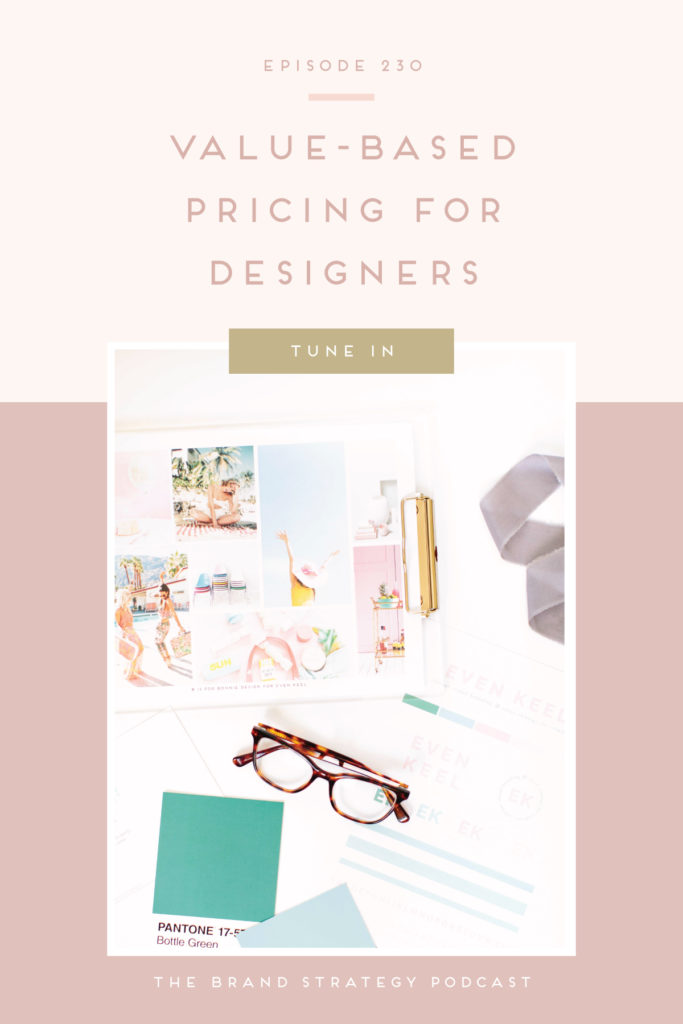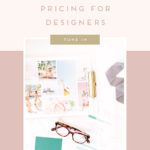Podcast: Play in new window | Download
Subscribe: Google Podcasts | Spotify | RSS

Pricing is one of the most difficult things we have to do in our businesses, especially when we’re not sure what our services are worth. In today’s episode, we’re covering everything you need to know to offer value-based pricing in your business! Listen in as we cover the mistakes you’re probably making in your pricing, how to define value-based pricing, and how to approach shifting to it in your business.
Mistakes in Pricing as a Designer
In my nearly 10+ years in the creative industry, I have seen this same mistake over and over again, where designers are pricing themselves based on either what the competition is charging or how much time it takes them to do whatever it is they were hired to do. We all start somewhere, but it’s time we pivot ass an industry away from this pricing mistake.
When you’re pricing based on your time commitment, consider what used to take you 10 hours to complete may now take you 6 hours. Should you be charging less for it? No. When you reach a certain point in your business where you have amassed a huge amount of skill, you’re really proficient at what you do, and you’re able to work quickly and effectively, that hourly model of pricing your work actually penalizes you.
Hourly pricing punishes you for being good at your job. That’s not the key to growing a profitable design business.
The Spending Habits of People
As you’re considering adjusting your pricing, here’s the honest truth: people buy what they want. They buy what solves their need or whatever aligns with their goals.
Your pricing isn’t just about what others are charging, but this is where most of us start in this space. What we need to turn to is value-based pricing.
What is Value-Based Pricing?
When you utilize value-based pricing, you’re pricing yourself based on how much value you deliver to your clients, not just the number of hours that it takes you to do the work.
Consider when you go to purchase something for yourself, you’re not thinking about the time it took to make or what it cost the company, you’re thinking about how it will serve you. You’re thinking about what it’s worth to you and how you’ll use it.
What Value-Based Pricing Does for Your Business
Value-based pricing allows you to determine the true willingness of your ideal client when it comes to your services and what they’re willing to pay. Additionally, it maximizes your profit since you’re not charging based on time anymore. It allows you to develop higher quality services. It also opens the door for you to think from your client’s perspective.
How to Utilize Value-Based Pricing in Your Design Business
When you’re switching to value-based pricing, you are flipping your pricing approach from how much time does it take me to do this to what value can I offer my client through this work, plus what is it worth to them?
My favorite approach to value-based pricing is through actually talking to your existing and ideal clients. This allows you to build your pricing directly from your customers.
Inside the Brand Strategy School, I have a sample survey that I share with my students that covers what you should be asking during these interviews. Big picture, this includes understanding how they define value within the context of your work, and then what they’d be willing to invest accordingly.
Value is Subjective
Now, value is subjective. Realistically, many of our clients are looking at prioritizing profit, or getting back more time, or ease of use in their website, etc. In looking at how your ideal client defines value, there are dollars attached to that. As a brand designer, a healthy rule of thumb to think about is that you want for your rate for your services to be a specific percentage of your client’s next year of revenue. If your client is wanting to make six figures, our industry shows that we should be charging 15-25% of that revenue, which would be between $15k and $25k.
If you’re not quite ready to charge that, it’s okay. You can scale back to meet your ideal clients where they are, as not all clients will have the same resources or needs. Just ensure that the value you’re providing to them and the pricing align with what you want to be charging.
You also get to set these prices how you want them based on your own dreams and financial goals. You are the owner of your business—set your value-based pricing according to what you’re providing.
FOLLOW ALONG
LIKE THE SHOW?
IN ORDER TO PROVIDE CONTENT YOU LOVE I WANT TO HEAR FROM YOU! SUBSCRIBE TO THE BRAND STRATEGY PODCAST AND LEAVE A 5-STAR REVIEW HERE. THE MORE REVIEWS, THE MORE I’M ABLE TO PROVIDE THIS FREE-ACTIONABLE CONTENT!

Review the Transcript:
Hi friend, and welcome to the brand strategy podcast. A show created to equip you with the inspiration, encouragement, and clarity. You need to build the brand of your dreams. I’m your host, Bonnie Bahktiari, brand designer, strategist, and founder of the Illume retreat from sustainable strategy to heartfelt encouragement. Each episode is designed to equip you with the tools you need to chase after your dreams, because you deserve a brand that empowers you to do what you love, connects with your dream clients and offers a deep sense of fulfillment along the way. So grab a cup of coffee and join me on this journey. Won’t you?
Friends. Welcome back to the brand strategy podcast, where today we are talking about value based pricing, specifically how to utilize value based pricing in your graphic brand or web design business. The reason why I am so excited to be talking about this specific concept today is because this is something that I not only teach inside my signature program for designers, the brand strategy school, but it’s also one of the keys that I have seen over the 10 years that I’ve been in business for designers going from being just a, you know, kind of struggling freelancer to having a, a truly profitable, purposeful and sought after design business. And value-based pricing is still one of those topics that in our industry, I see some misinformation around some confusion around. And so I think that this is a conversation that can allow us to just bring more clarity to this topic so that we can understand not only what value-based pricing is, but what it means for your design business.
So if you are tuning in today and you are ready to break up with that feeling in your design business, where you’re busy, but broke, if you are ready to not struggle to figure out what to price your services with every new inquiry you receive, and you’re ready to trade the way that you’ve been pricing your work in the past, probably based on the time that it takes you to complete it for a much more sustainable and scalable and ultimately profitable method, you are in the right place. So friend, like I was saying over the 10 years that I’ve been a designer and over the gosh, and I have to do some quick mental math, which is not my strong suit. over basically the seven years that I’ve been an educator in the creative industry. I have seen over and over again, how many designers are pricing themselves based on either what the competition is, charging, which, you know, valid, we all start somewhere, or they are charging for their work based on how much time it takes them to do whatever it is they were hired to do.
So, for example, if it takes you 10 hours to design a website, you are factoring your pricing that you, uh, you know, shared with that potential client based on your hourly rate times 10, 10 hours of work, right? But here’s the thing. When you reach a certain point in your business where you have amassed a huge amount of skill, you are really proficient at what you do, and you’re able to work quickly and effectively that hourly model of pricing, your work actually penalizes you. So let’s say when you first got started, it took you 10 hours to design a website, and now it takes you like six. If you’re following the hourly pricing model. Yes. Hopefully you’re actually increasing your hourly design rate year after year, but still there comes a, a point where your hourly rate reaches a ceiling as to what the market can sustain per hour of work.
Then you also hit that point where the, the math isn’t in your favor, you’re working less, but you’re not necessarily making more. So my beef with hourly pricing is that it punishes you for being good at your job. It punishes you for being talented and skillful for working more efficiently and more effectively for having good workflows that are helping you save time. And that’s not the key from my perspective, that’s not the key to growing an incredibly exponentially profitable business. And for me personally, that certainly was not a method that allowed me to build the wildly profitable design business that I have today. And that’s why I teach this inside the brand strategy school. Because if I’m gonna show you as a designer, how to reach consistent 10 K months and scale beyond that, by leveraging brand strategy as your superpower, we need to think about the mindset that you want to have and how you’re structuring your services and how you’re figuring out your prices so that you can command top dollar for quality design work.
So as we dive deeper into this topic, if you only take away one thought from today’s episode, I want it to be this people buy what they want. And what I mean by that is they buy what solves their need or what they perceive to be the most value that aligns with their goals. So, so much more goes into your pricing than just, you know, making up numbers or just copying the prices that your competitor is currently charging. But like when we first start our businesses, like I said, we, we usually start at that point of looking to what the competition is doing. So we’re, we’re using competition based pricing. So we’re looking at what other people are doing and we’re matching it, or we’re charging base solely on our time. And these are great strategies to use within your first few years of business.
So if you’re tuning in and you’re like within your first one to three years of business, and that’s still what you’re doing, you’re not doing it wrong. Um, honestly I don’t think there is a wrong way to do it. It’s just finding what serves you best. And I do believe based on my years of experience, working with hundreds of designers from all over the world, that you’re eventually gonna reach a point where pricing based on what the competition is, charging or pricing based on how much time goes into your work is not gonna serve you in, in the best way possible through the brand strategy blueprint, which is what I teach. That’s my method that I teach inside the brand strategy school I share with designers, all the tools that they need in order to supercharge the value of their services. So that means that you begin to change the way you’re that you’re pricing yourself.
And that’s where we bring in value based pricing. Now with value based pricing, you’re pricing yourself based on how much value you deliver to your clients, not just the number of hours that it takes you to do the work. And here’s where things start to get interesting friend, let’s kind of like break, break down this concept a little bit more. If I were to say by a new planner, a new, you know, beautiful, pretty paper planner or agenda for my business. I’m not thinking about how much time it took that company to design it or manufacture it. I’m not thinking about the cost of the binding or the cost of the paper, or if there’s like a really pretty bookmark or something in it. I’m not thinking about any of that. I’m only thinking about the finished product. I’m thinking about, you know, the aesthetics I’m thinking about the function I’m thinking about, uh, you know, what kind of space will this take up on my desk?
What kind of structure are the individual pages? Will this work with the way that I plan out my day or my week? So actually what I’m doing as a consumer, I’m thinking about what that planner is worth to me, what it means to me, I’m thinking about the perceived value that I place on that object. And that is 100% dependent on who I am, what I find valuable, my worldview, et cetera. So see, this is the key with value based pricing. It cuts through the red tape of that scenario to determine the true willingness to pay of who you are trying to reach based on what they’re trying to buy from you. So value based pricing cuts through all of that. And it’s not asking me to think about what the manufacturing costs were. It’s not asking me to think about how much time went into actually producing the planner.
It’s asking me as the consumer to think about what am I willing to invest in this? What is this piece of work or this service, what is that worth to me? And here’s why I am such a massive fan of this. This allows you to determine the true willingness of your ideal client when it comes to your services. So value-based pricing does some magical things for you. From my perspective, it allows you to maximize profit, right? Because we’re not charging based on our time anymore. It allows you to develop higher quality services. So it, you, you’re putting yourself in the shoes of the consumer, in the shoes of your ideal client, and it’s gonna also then help you discover what your clients are really looking for in the solution that you’re providing to them as a brand designer, a web designer, or a graphic designer.
And then it allows you to wow, your client in the end, and truly deliver a level of service that aligns with their expectations. This holds true because the value based pricing depends on asking your ideal client, what they want from you. What they’d be willing to invest, how much they’d be willing to pay for the results that you deliver. And in the end, this allows you to craft offers that meet your ideal clients, exactly where they are. Now. I do wanna say that with value based pricing, right? We’re flipping our method here for pricing. From how much time does it take me to do this, to what value can I offer my client through this work? And what is it worth to them? So there’s some, some research that we wanna do here. We don’t wanna just look at what other, you know, designers of comparable skill or, you know, number of years in business are charging.
We want to look at, um, you know, thinking about what will this be worth to your ideal clients? And so here’s where we actually can kind of like put on our, um, our scientist hat a little bit, or maybe your, a detective hat. If that speaks to you more, we can do a little bit of information gathering. We can, we can harvest some data basically. And my favorite way to do this is by actually talking to your ideal clients. This is something that I’ve talked about multiple times here on the podcast, or, um, on the blog in the past years. And if you haven’t done this yet, or maybe if it’s been a while, I highly encourage you to do this because talking to your ideal clients, talking to the actual living, breathing humans that make up your target demographic gives you so much insight into who they are and what they value, where they’re struggling, what their goals are, um, what their values are.
And it allows you to then create not only your offers around this information, but then also allows you to, to really build out your messaging and your marketing plan with these incredible humans in mind. So all of a sudden, from our standpoint, as, as business owners, our marketing, our messaging, our offers, we’re not creating them in a vacuum. We’re not creating them based on guesses and estimations and, you know, just kind of taken a, taken a good old guess. Instead, we are building all of that out based on true actual data, actual information that we’ve gathered from people. So actually inside the brand strategy school I have, um, I actually have a, a, you know, question by question sample survey that I share with the designers inside that program. So they can see exactly the kinds of questions that I recommend asking in these interviews and how to structure them.
But basically what you’re wanting to do here is you’re wanting to figure out what value your ideal client is looking for, how they define value within the context of your work, and then what they’d be willing to invest accordingly as a designer, when you’re working with entrepreneurs with small business owners, with companies, one of the most important kind of qualifiers, one of the sort of markers that people are looking for when they hire a brand designer, a web designer or strategist, is they’re looking for someone who can help them generate more sales or create more revenue, essentially. So that’s one pretty healthy, um, pretty easy and universal kind of marker to look for when you’re talking with your I O clients or when you’re structuring your services by using value based pricing. So if we let’s say, and of course I, I do need to mention that value is subjective, right?
So what I’ve seen from my clients where they’re prioritizing profit, it might be something different for your ideal clients. They might be prioritizing time or ease, convenience, um, you know, things of that nature. So this is not Canon. This is just based on what I’ve seen from the, my students over the years and also my own clients. But that being said, if, if, if we’re looking at how your ideal client defines value, and there’s some dollars attached to that, there’s, you know, some, some financial gain as a part of that equation, then a healthy rule of thumb to think about is that you want for your rate for your services to be a specific percentage of your client’s first year of revenue or their next year of revenue, if they’ve been in business for a while. So if your client is coming to you and they’re asking you to create a brand that will help them make six figures this year, a hundred thousand dollars, then the data tells us and industry research shows us that between 15 and 25% is a healthy percentage and where your fees should be.
So if your client expects to earn a hundred thousand dollars, then you would wanna charge between 15,000 and $25,000. But I know, I know if you’re tuning in today and you’re, you’re not quite at that point yet where you’re charging that amount for your services. That’s okay. If you’re not close to charging that kind of rate, just yet think of it as something to work towards. Um, and also if your ideal clients don’t have that kind of budget, that’s also okay. We just then scale back accordingly. And in order to figure out how to charge for the value that your work delivers, we just, we wanna learn more about your leads. We wanna talk to your ideal clients about the financial goals that they’re trying to achieve, and then, you know, just pricing your work accordingly. I think it’s important to also mention that there’s something incredibly valuable about serving clients who maybe don’t have the budget of investing, you know, $25,000 in brand and design services.
At this point, maybe that’s something they’re working towards, but maybe this is a smaller business and they are wanting to invest much less than that. That’s also valid, that’s worthy. I know that I talk a lot about how to charge more for your services, how to command higher end rates as a designer and how to, you know, build that kind of profitable design business. But there are multiple ways to build a profitable design business. And also ultimately you’re the one who defines what profitability looks like, you know, your financial need, you know, how you define success. And so I’m never gonna sit here and say that you need to be charging 10 grand for your design services. If that, first of all, alienates the people that you feel called to serve. And also if that doesn’t align with your financial goals or the amount of time that you wanna be spending in your business, that’s the beauty of being an entrepreneur of running your own business of being the CEO of this company that you’re building is you get to decide what goals you’re pursuing and what success looks like to you.
So with that being said, I don’t want you to feel any pressure if charging 15 K 25 K 30 K plus, if that is like not, not scary, exciting, it’s just plain scary. That’s okay. There’s something incredibly valuable about, about being where you are being in the season of business that you’re in and serving the people that you serve, especially if you think about working with nonprofits or you, or wanting to work with, um, people who are in different seasons of life or, um, of different socioeconomic backgrounds, they deserve to have high quality work as well. They might not have a massive budget and that’s okay. There’s something really powerful about, um, about, you know, knowing that and, and owning that I was actually having a conversation with, um, one of the designers inside the brand strategy school, uh, a couple weeks ago. And she posed the question of, you know, Hey, like I really, really love the work that I do, and I want to be building a profitable, scalable design business, but I know that for my ideal clients, they are working with limited budgets, but I love working with them.
It’s so fulfilling to work with them. And I know that I’m making a difference when I serve this market. And basically her question was like, is, is this okay? Like, am I doing this wrong? And it was so powerful because we got to have a conversation in the group about how it is absolutely valuable and valid and worthy, and, and also a sustainable method of business to serve people at different points and their own journey and to serve clients who are at have different budgets. Essentially, I know that our design industry, especially kind of prioritizes those, those incredible clients who have these big budgets and these companies with deep pockets. But I can remember years when I didn’t have a big budget to invest in my business. I remember what it’s like building something from scratch without any kind of, you know, external funding or anything like that.
And a lot of people are in that same position. So with value based pricing, I know that this got a little bit, a little bit tangenty , but what I’m trying to say is that with value based pricing, you get to determine with your ideal clients, by doing the research, what value looks like to them, and is that an alignment with what you want to be charging for your services based on, you know, the yes or no answer, you then get to decide how to move forward and how to structure packages that are more attractive to your ideal client. Because again, we’re changing the conversation, whether you’re charging $5,000 for your services or $500,000 for your services, the, the conversation becomes not about I can do a, B and C for you in, you know, X number of hours. It becomes I can help you achieve these specific goals that you shared with me through this specific level of service.
And if you want that transformation, this is the investment that will get you to that point. And then the conversation becomes about what, what your ideal client is wanting to experience and how excited they are to experience that growth. Because you, as the expert are gonna guide them through your signature design process, your strategy process that empowers them to, to experience those wins. And the beautiful thing is right. We’re not getting caught up in the amount of time that it takes us to create those Del those deliverables or to deliver that result. We are 100% focused on the value of our work, and we’re receiving an amount of money that is comparable with the transformation or the result that our work delivers, regardless of how long or how quickly you’re able to do that work. So, friend, I hope that this helps to create a little bit more clarity, give you a little bit more idea around what value based pricing is, what it can look like for your design business and how you can actually take that next step in order to switch from price, from pricing, based on the competition or pricing based on, um, the hours.
It takes you to do the work too, pricing yourself based on the value that your ideal clients perceive through your incredible work. And I know that throughout today’s episode, I’ve been talking about the brand strategy school. If you’re curious about my signature program for graphic brand and web designers who are on their way to generate consistent 10 K months by leveraging brand strategy, as the value add and superpower they need, you can head on over to my website@bsforbonniedesign.com slash brand strategy dash school, to learn more about joining, or if you’re curious about how, not only by leveraging value based pricing, but by leveraging some really thoughtful growth oriented strategies, I was able to take my business from a struggling freight answer to now having an incredibly profitable and sought after design business. I have a totally free on demand training for graphic brand and web designers that shows you how you can exponentially increase your income while honoring your time and energy.
And you can just go to BS for Bonnie design.com/training to grab your free seat and check out that on demand class friend is always, I appreciate you tuning into today’s episode. I hope this was helpful. And if you have any questions for me, if you wanna continue this conversation around value-based pricing, or if you have, um, already done your homework, you’ve, you know, did done some interviews with your ideal clients and you are like implementing what we’ve been talking about today. I wanna hear about it. I’d love to connect with you. You can, uh, connect with me probably the quickest way to get ahold of me is on Instagram. You can reach out at Bonnie joy. Marie is where you can find me. And I would love to chat with you more and just hear how this is going for you. And if this is something that is serving you well on your journey to grow your design business, as always, I appreciate you being a part of the brand strategy podcast community, and I’m grateful for your support. And of course, I will be cheering you on from Waco. And I can’t wait to, and I was gonna say, see, but you know, with this podcast format, not really seeing more, just like hanging out in your ears, which is a weird thing to say, but now it’s out there. So we’re going with it. So that being said, I’m always cheering you on. You’ve got someone who believes in you and is in your corner all the way from Waco, Texas. And I already can’t wait to get to virtually hang out with you next time.
Thank you so much for joining me today. Friends, before you go, I would be so grateful to receive your feedback on the brand strategy podcast. If you enjoyed this episode or the podcast in general has helped you grow your brand. I’d really appreciate it. If you left us a review in iTunes, your positive reviews enable the brand strategy podcast to continue to grow and reach like-minded creatives. Just like you. Thank you for all your support and encouragement as together. We pursue building brands with purpose and intention until next time and cheer you on from Waco.





leave a comment